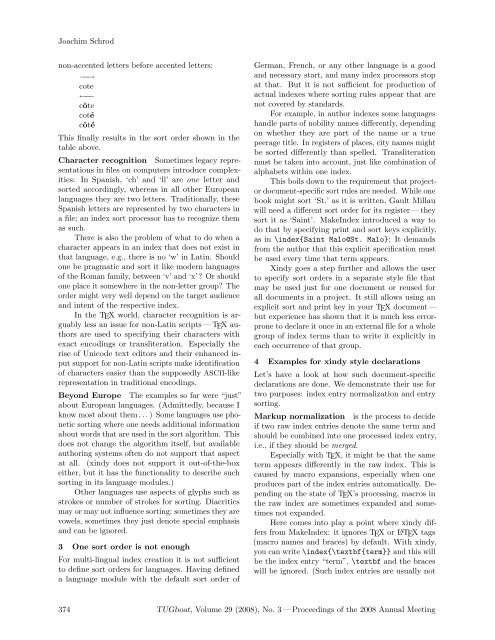The Communications of the TEX Users Group Volume 29 ... - TUG
The Communications of the TEX Users Group Volume 29 ... - TUG
The Communications of the TEX Users Group Volume 29 ... - TUG
Create successful ePaper yourself
Turn your PDF publications into a flip-book with our unique Google optimized e-Paper software.
Joachim Schrod<br />
non-accented letters before accented letters:<br />
−−→<br />
cote<br />
←−−<br />
côte<br />
coté<br />
côté<br />
This finally results in <strong>the</strong> sort order shown in <strong>the</strong><br />
table above.<br />
Character recognition Sometimes legacy representations<br />
in files on computers introduce complexities:<br />
In Spanish, ‘ch’ and ‘ll’ are one letter and<br />
sorted accordingly, whereas in all o<strong>the</strong>r European<br />
languages <strong>the</strong>y are two letters. Traditionally, <strong>the</strong>se<br />
Spanish letters are represented by two characters in<br />
a file; an index sort processor has to recognize <strong>the</strong>m<br />
as such.<br />
<strong>The</strong>re is also <strong>the</strong> problem <strong>of</strong> what to do when a<br />
character appears in an index that does not exist in<br />
that language, e.g., <strong>the</strong>re is no ‘w’ in Latin. Should<br />
one be pragmatic and sort it like modern languages<br />
<strong>of</strong> <strong>the</strong> Roman family, between ‘v’ and ‘x’? Or should<br />
one place it somewhere in <strong>the</strong> non-letter group? <strong>The</strong><br />
order might very well depend on <strong>the</strong> target audience<br />
and intent <strong>of</strong> <strong>the</strong> respective index.<br />
In <strong>the</strong> <strong>TEX</strong> world, character recognition is arguably<br />
less an issue for non-Latin scripts — <strong>TEX</strong> authors<br />
are used to specifying <strong>the</strong>ir characters with<br />
exact encodings or transliteration. Especially <strong>the</strong><br />
rise <strong>of</strong> Unicode text editors and <strong>the</strong>ir enhanced input<br />
support for non-Latin scripts make identification<br />
<strong>of</strong> characters easier than <strong>the</strong> supposedly ASCII-like<br />
representation in traditional encodings.<br />
Beyond Europe <strong>The</strong> examples so far were “just”<br />
about European languages. (Admittedly, because I<br />
know most about <strong>the</strong>m . . . ) Some languages use phonetic<br />
sorting where one needs additional information<br />
about words that are used in <strong>the</strong> sort algorithm. This<br />
does not change <strong>the</strong> algorithm itself, but available<br />
authoring systems <strong>of</strong>ten do not support that aspect<br />
at all. (xindy does not support it out-<strong>of</strong>-<strong>the</strong>-box<br />
ei<strong>the</strong>r, but it has <strong>the</strong> functionality to describe such<br />
sorting in its language modules.)<br />
O<strong>the</strong>r languages use aspects <strong>of</strong> glyphs such as<br />
strokes or number <strong>of</strong> strokes for sorting. Diacritics<br />
may or may not influence sorting; sometimes <strong>the</strong>y are<br />
vowels, sometimes <strong>the</strong>y just denote special emphasis<br />
and can be ignored.<br />
3 One sort order is not enough<br />
For multi-lingual index creation it is not sufficient<br />
to define sort orders for languages. Having defined<br />
a language module with <strong>the</strong> default sort order <strong>of</strong><br />
German, French, or any o<strong>the</strong>r language is a good<br />
and necessary start, and many index processors stop<br />
at that. But it is not sufficient for production <strong>of</strong><br />
actual indexes where sorting rules appear that are<br />
not covered by standards.<br />
For example, in author indexes some languages<br />
handle parts <strong>of</strong> nobility names differently, depending<br />
on whe<strong>the</strong>r <strong>the</strong>y are part <strong>of</strong> <strong>the</strong> name or a true<br />
peerage title. In registers <strong>of</strong> places, city names might<br />
be sorted differently than spelled. Transliteration<br />
must be taken into account, just like combination <strong>of</strong><br />
alphabets within one index.<br />
This boils down to <strong>the</strong> requirement that projector<br />
document-specific sort rules are needed. While one<br />
book might sort ‘St.’ as it is written, Gault Millau<br />
will need a different sort order for its register — <strong>the</strong>y<br />
sort it as ‘Saint’. MakeIndex introduced a way to<br />
do that by specifying print and sort keys explicitly,<br />
as in \index{Saint Malo@St. Malo}: It demands<br />
from <strong>the</strong> author that this explicit specification must<br />
be used every time that term appears.<br />
Xindy goes a step fur<strong>the</strong>r and allows <strong>the</strong> user<br />
to specify sort orders in a separate style file that<br />
may be used just for one document or reused for<br />
all documents in a project. It still allows using an<br />
explicit sort and print key in your <strong>TEX</strong> document —<br />
but experience has shown that it is much less errorprone<br />
to declare it once in an external file for a whole<br />
group <strong>of</strong> index terms than to write it explicitly in<br />
each occurrence <strong>of</strong> that group.<br />
4 Examples for xindy style declarations<br />
Let’s have a look at how such document-specific<br />
declarations are done. We demonstrate <strong>the</strong>ir use for<br />
two purposes: index entry normalization and entry<br />
sorting.<br />
Markup normalization is <strong>the</strong> process to decide<br />
if two raw index entries denote <strong>the</strong> same term and<br />
should be combined into one processed index entry,<br />
i.e., if <strong>the</strong>y should be merged.<br />
Especially with <strong>TEX</strong>, it might be that <strong>the</strong> same<br />
term appears differently in <strong>the</strong> raw index. This is<br />
caused by macro expansions, especially when one<br />
produces part <strong>of</strong> <strong>the</strong> index entries automatically. Depending<br />
on <strong>the</strong> state <strong>of</strong> <strong>TEX</strong>’s processing, macros in<br />
<strong>the</strong> raw index are sometimes expanded and sometimes<br />
not expanded.<br />
Here comes into play a point where xindy differs<br />
from MakeIndex: it ignores <strong>TEX</strong> or L A<strong>TEX</strong> tags<br />
(macro names and braces) by default. With xindy,<br />
you can write \index{\textbf{term}} and this will<br />
be <strong>the</strong> index entry “term”, \textbf and <strong>the</strong> braces<br />
will be ignored. (Such index entries are usually not<br />
374 <strong>TUG</strong>boat, <strong>Volume</strong> <strong>29</strong> (2008), No. 3 — Proceedings <strong>of</strong> <strong>the</strong> 2008 Annual Meeting

















